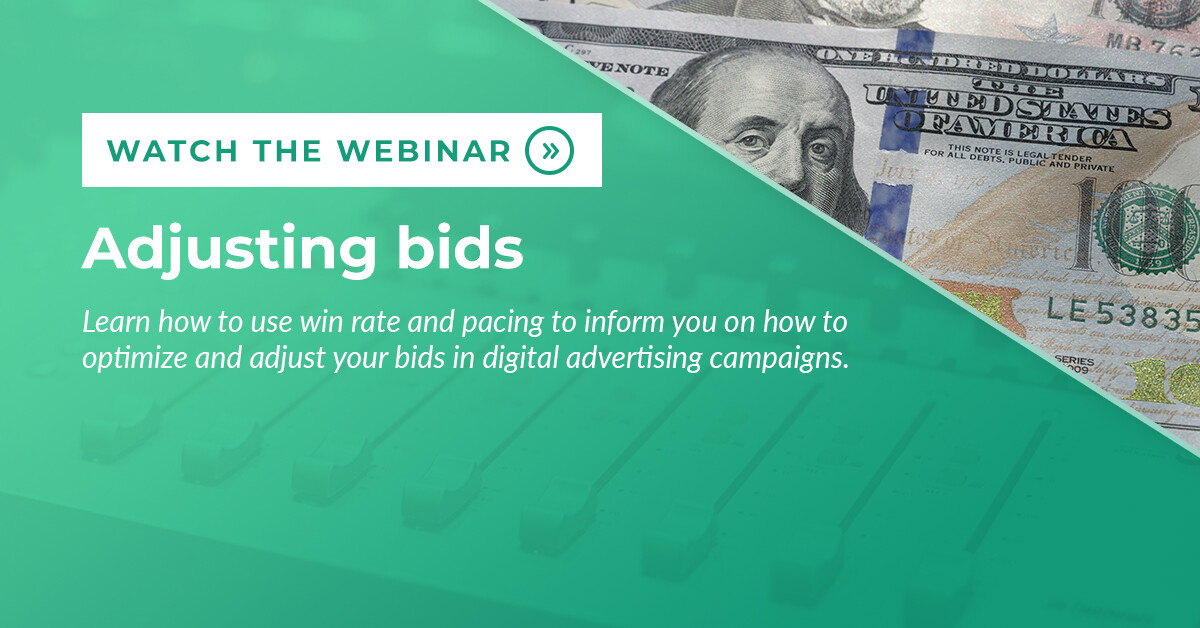Your digital advertising campaign is all set (and running well!), but after a couple of weeks, you start to see a downturn in overall performance. Or maybe you just aren’t sure how to get started with CPMs. We covered all of that in this webinar, along with how to use win rate and pacing to optimize your campaign bid adjustments.
Jump to:
Watch the webinar
 Webinar transcript
Webinar transcript
Rob Brockmann, Growth Account Management Director: Hey, everyone. Thank you for joining us for our guide to campaign bid adjustments.
We’re going to tackle this topic in a few sections: First, we’ll get a refresher on the real-time bidding environment. Then, we’ll go over how bids and CPMs work. Finally, we’ll cover the what, the why, the how, and the when of adjusting bids for maximum campaign optimization.
Let’s start with a refresher on how a real-time digital advertising auction, or real-time bidding (RTB), works. To give you some context, we often compare this to the stock market. First, a user visits a website. This is the very beginning of the art auction lifecycle. Next, an ad exchange announces the available bids to a bid manager. This is where your creative types, sizes, and targeting strategies all come into play. The bid manager then evaluates the advertisers targeting and bids it matches. The auction now takes place for the open ad inventory. And this is where your minimum and maximum bids first make an appearance. Finally, the winning exchange serves the ad. These ads are bought and sold in a dynamic environment where you will have to be responsive in updating and adjusting your bids’ rates to reflect the organic price floor of your target audience and the costs to reach them.
It will be helpful to know what a bid is actually made of. There are a few distinct things to point out. First, your base bid is your entry bid and will get your foot in the door to the RTB auction. The initial base bid you set at the ad group level will greatly determine how competitive you are in the auction. Think of your max bid as your ceiling bid, or how much you were willing to spend at most per CPM. The higher your ceiling, the longer you can stay in the game.
The CPM is the total price you pay for every 1000 impressions. While we can’t truly estimate what your actual CPMs will be, the base and max bids you have set, along with any associated data CPMs, will be key in determining your average CPM aims for any given campaign. Thinking of this as a math equation, your total CPM is the result of any associated data CPMs as well as your ad placement CPM. Keep these bid factors in mind when setting and adjusting your bids.
The CPM cheat sheet is a great resource for deciding where to set your base and max bids. The CPM cheat sheet breaks down CPMs by various targeting tactics. Note that this resource is based on a nation-wide geolocation and a single targeting tactic.
Now, let’s talk about strategy and best practices for setting and adjusting your bids. The higher you set your initial base CPM bid, the greater the chance that your ad will be served as an impression. Remember, your base bid is your entry bid and will get your foot in the door to the RTB auction.
Here’s some great news for you as an advertiser. Ad exchanges charge only what is needed to place an ad above the next highest bidder. For example, if your bid was three dollars and fifty cents, and the next highest bid was three dollars, you will win that auction at three dollars and one cent. As a best practice, we typically recommend a base to max CPM bid ratio of one to two or one to three. Using this strategy should make optimizing and adjusting bids that much easier.
Keep in mind that narrowly targeted ad groups and audiences with smaller potential reaches typically require a more aggressive bidding strategy from the onset of your campaign.
Setting your base and Max CPM bids for retargeting requires you to adopt a different bidding strategy as bids for retargeting campaigns can vary widely depending on how large the user pool is inside of your Choozle Smart Container Tag. If you have a relatively small user pool, you will typically need to bid more aggressively to win those impressions and serve ads to the users in your retargeting audience.
Next, let’s take a minute to watch a video that puts it all together. Check your campaign and ad group’s pacing bars to help determine what bid adjustments to make. To adjust your bids from the campaign’s dashboard, click on the base and max bids tab, adjust the bids as desired, and save, always keeping in mind the one to two and one to three base to max bid ratio.
Now that we’ve made it through the what, the how, and the why, let’s cover the when aspect. Using the following benchmarks will help you strategize about when to look for and execute bid adjustment optimizations.
- Day 1: Ensure your campaigns have launched and all ad groups are firing successfully.
- Week 1: Check your pacing by week’s end to make sure that your click-through and win rates are aligned with the overall goals of your campaign. As a baseline, look for a click-through rate of point 0.7 or higher and that your win rate is between 10 and 30 percent.
- Weeks 1 to 2: Based on the data that has been gathered during your first week or two, make data-driven optimizations to your bids to try and reach those campaign goals.
- Weeks 2 to 4: Check key performance indicators and continue to optimize through bid adjustments until the end of the campaign.
That’s it. Thank you for joining us for this webinar today on adjusting bids. Don’t forget to join us next time.
FAQs
Is there such thing as the “perfect bid”?
Many people ask about “the perfect bid” during campaign setup, but really, there’s no such thing (only recommended starting points). We encourage you to manipulate your bids based on performance throughout the campaign, not just a one-and-done adjustment.
What’s a good increment for a bid adjustment?
Another question we get is around a good increment for a bid adjustment. Depending on the ad group’s win rate, you can tweak bids anywhere from $0.25 to a few dollars! Again, there’s no magic answer here, but there is likely a magic number for each individual campaign to maximize the budget while winning as many impressions as possible.
What’s the point of a max bid if the average CPM for an ad group can be higher?
The max bid only applies to the media placement CPM, not the data CPM. If you have a specific CPM you can’t exceed, you’ll need to factor in your audience’s data cost and lower bids accordingly. The estimated CPM tool in the ad group setup is a huge help for this kind of calculation.







